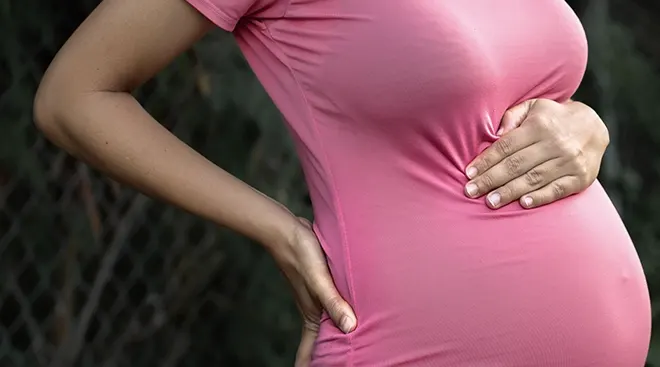How to Do Kick Counts (and When to Start)
Pregnancy is filled with ups, downs and many unknowns. It’s normal to wonder whether baby’s okay, especially when you don’t know exactly what’s going on in the womb. But once you enter your third trimester, there’s an easy, free, at-home technique you can use to monitor baby’s wellbeing: fetal kick counts. We tapped experts to break down everything you need to know about baby kick counts, including why they’re important, when and how to do them and when to call your doctor about decreased movement.
Fetal kick counts are an at-home method you can use in late pregnancy to track baby’s movement and help assess their health in utero, says Kristin Atkins, MD, FACOG, an assistant professor in the Obstetrics and Gynecology Department at Howard University College of Medicine. Kick counts measure how long it takes baby to move 10 times—ideally, you’ll sense 10 movements within two hours or less. Almost any fetal movement can be used for baby kick counts, including kicks, flutters, swishes, jabs or rolls. (Note, though, that hiccups don’t count, since they’re involuntary.)
Fetal kick counts are a way to track baby’s wellbeing before birth: They can help identify potential problems and help prevent stillbirth. In familiarizing yourself with baby’s habits and patterns, you’ll be able to better sense when something might be off, explains Megan Cheney, MD, MPH, medical director of the Women’s Institute at Banner University Medical Center Phoenix. Letting your doctor know if baby is moving significantly more or less than usual will help them address any issues and take action if baby is in distress. In other words, kick counts are something you can do all on your own to help keep baby safe. Not only that, but getting in tune with baby’s movements is also a great way to start the bonding process.
Wondering when to start counting kicks? Doctors generally recommend starting once you enter your third trimester, at 28 weeks. Why not sooner? You’ll likely start to feel those first flutters of movement between 16 and 22 weeks, but they’ll be subtle and irregular. “Earlier than 28 weeks, baby doesn’t have a pattern yet. Any movement is good,” Cheney says. But you can start regularly counting kicks at 28 weeks—by then, baby’s kicks will become stronger and more predictable.
There are several methods doctors may use to perform kick counts—and there’s no one “best” method. Whatever method you and your doctor decide to use, it’s important to fully understand what’s considered normal and when to call the doctor or go to the hospital. If you’re not entirely clear on this or have questions as you start to do kick counts, don’t hesitate to ask your doctor.
One method for performing baby kick counts is to time how long it takes to count 10 fetal movements. “Any movement counts, and the number of movements is more important than the strength of the movement,” Atkins says. Many women reach the 10-count within the first 30 minutes, but it could take up to an hour or two, and that’s okay.
Because it takes some concentration, start your kick counts when you’re feeling relaxed and focused, Cheney says. You can technically do baby kick counts in any position, but it’s best to lie down on your left side with your hands on your bump—this increases blood flow, which helps get baby moving.
Wondering how often you need to do kick counts? At least once a day, says Atkins, or anytime you or your healthcare provider are concerned about baby. Try for roughly the same time each day, and pay attention to when baby tends to be most active (more on this below.) When you’re doing baby kick counts, keep a physical tally and write down the time of the first and tenth movement. The key here is to understand your child’s individual patterns and then look for “significant deviations,” according to the American Pregnancy Association. There can be a range of time differences in kick counts, so look for big differences over the course of three to four days.
If you still haven’t counted 10 movements after two hours, or if there’s a noticeable or long-term change from the norm, give your doctor a call. “They may want to bring you in and put you on a monitor,” Cheney adds. “Most of the time baby is doing fine, but better be safe than sorry.”
It’s important to note that some pregnancy conditions that affect baby’s position, the placenta’s location (like anterior placenta) or your amniotic fluid levels may impact your ability to feel baby’s movement and accurately count their kicks. “The feeling comes from the movement of baby against the abdomen, so if the extremities are toward the back, or the placenta is between baby and the abdomen, this may decrease the feelings of movement that the patient has,” Atkins says. If you have a condition that limits your ability to feel baby’s kicks, work with your doctor or midwife to come up with a specialized plan for how to monitor baby’s wellbeing.
Additionally, as you reach the end of your pregnancy, baby’s movement shouldn’t decrease, but it may feel different than what you’ve become accustomed to. “That’s often because baby doesn’t have as much space to line up and take a big kick. Instead, babies do more shoulder rolls—and that still counts,” Cheney says.
If fetal movement seems slow to start or if the number of kicks within that two-hour window are low, try to get baby to move. According to the APA, you may get higher kick counts by:
- Lying on your left side—as mentioned above, this helps increase blood flow
- Eating a meal or something sweet, or drinking juice
- Drinking something cold (like iced water or a glass of milk)
- Exercising
- Doing kick counts between 9 p.m. and 1 a.m. (just as baby moves when blood sugar spikes, they also move due to declining blood sugar levels)
These tips will often help perk baby up and prompt them to move around a little. If baby’s kick counts aren’t high enough after two hours, call your healthcare provider. It’s worth noting that some doctors prefer to be notified if baby’s kick counts don’t reach 10 within an hour (instead of two), so talk to your provider about their recommended protocol for your pregnancy.
About the experts:
Kristin Atkins, MD, FACOG, is a maternal fetal health medicine specialist. She earned her medical degree from Eastern Virginia Medical School and has served as an assistant professor at NYU School of Medicine and University of Maryland School of Medicine. Currently, she is an assistant professor in the Obstetrics and Gynecology Department at Howard University College of Medicine.
Megan Cheney, MD, MPH, is the medical director of the Women’s Institute at Banner University Medical Center Phoenix. She earned her medical degree and a Master’s degree in public health from the University of Arizona.
Please note: The Bump and the materials and information it contains are not intended to, and do not constitute, medical or other health advice or diagnosis and should not be used as such. You should always consult with a qualified physician or health professional about your specific circumstances.
Plus, more from The Bump:
Navigate forward to interact with the calendar and select a date. Press the question mark key to get the keyboard shortcuts for changing dates.





















































